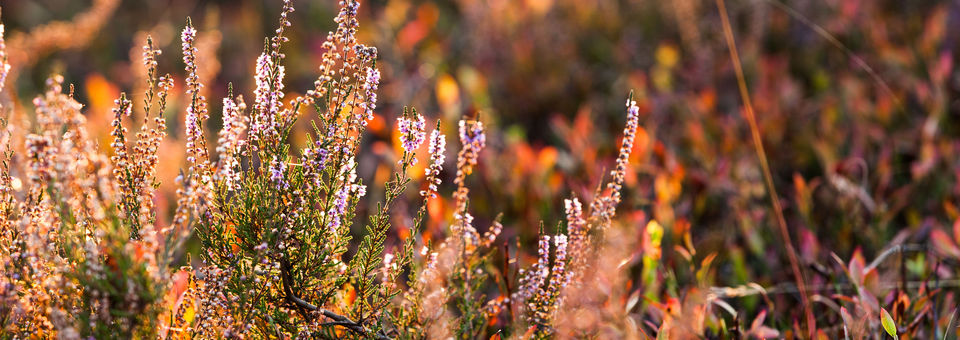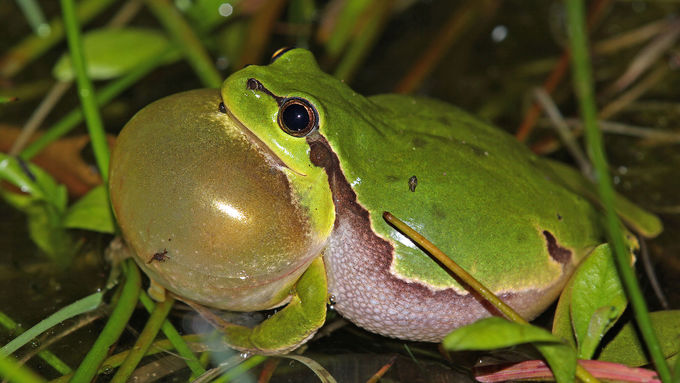Europäischer Laubfrosch/European Tree frog (Hyla arborea) © Christian Fischer, CC BY-SA 3.0
download picturemain content
Protected Species
HYLA ARBOREA (1203)
European Tree Frog
The European Tree Frog is a small tree frog which reaches a body length of three to four centimetres. As a good climber, he likes to stay in bushes and trees, where his green colour provides an excellent camouflage. Characteristics for the species are adhesive discs on the tips of the fingers and toes which allow the tree frog to climb on smooth surface. The upper side of the animals is usually coloured light green; the ventral side is whitish-grey. Occasionally also brown, grey, yellowish or spotted specimens occur. Subadult animals have a lighter green, partly golden colour. Adult animals have a black, often off-white strip running from the nostrils to the clearly visible tympanum and along the flanks along the legs. The males have a yellow-orange to brownish coloured vocal sac at the throat. During the mating season from the end of April to mid-June, the call of the males - a very loud, rhythmic "epp ... epp ... epp" - can be heard over a long distance in the dark.
Habitat and biology
The European Tree Frog is a character species of the rural countryside with its abundant ponds, meadows and pastures in a landscape that is richly structured with shrubs and hedges. Original habitats were flood plains with climatically favourable conditions. As spawning waters, ponds, pools, puddles, temporary puddles, oxbow lakes, and sometimes also larger lakes are used. The species prefers waterbodies with abundant vegetation that is fully exposed to sunlight and without fish. Outside the breeding season, tree frogs stay in higher vegetation (e.g. blackberry hedges, reeds, shrubs, canopy of trees). They hibernate on land where they hide in forest areas, field spinneys or borders in root cavities or burrows.
Already in early spring from the end of February, the first tree frogs find their waterbodies for calling. Only at higher temperatures the breeding phase begins from the middle or end of April, with a main spawning season in May and June. Approximately 250 to 1,100 eggs are attached to plants in shallow water zones in numerous walnut-sized spawning clusters containing up to 80 eggs each. Depending on the weather and nutritional conditions, the larval phase lasts 40 to 100 days. Depending on the water temperature, the converted cubs then leave the water between July and August. The adult animals look for their winter quarters from the end of September to mid-October. The colonization of new waterbodies takes place mainly by the subadult tree frogs. But also the adult animals are very mobile and have an average range of 500 meters around the spawning waters. In exceptional cases distances of up to 12 kilometres can be covered. Sexual maturity usually begins after two years. Even though it is known that one-year-old males may be reproductively active, it is questionable whether this leads to successful mating. The lifespan in the wild is five years at most, in captivity tree frogs are known to reach the age of 22 years.
Occurrence
The European Tree Frog is classified as “Endangered“ (EN) in North Rhine-Westphalia and dependent on conservation actions. Significant main areas of distribution are the lowlands in the Münsterland area.
In Lower Saxony, the tree frog is also considered “Endangered” (EN, NLWKN 2013) and settles in the lowland regions in different constancy and population densities. The species has suffered from enormous habitat loss and fragmentation in the past few decades.
Threats
The fundamental threats can be attributed to the loss or degradation of calling and spawning waters, for example through intensive agriculture, hydraulic actions, removal of shallow water areas, backfilling, development, reforestation, succession or fish stock as well as to the loss or the degradation of terrestrial habitats (grassland, borders, hedges, bushes, groups of trees) and changes in the water balance in wetlands (especially groundwater subsidence). In addition, the species is threatened by the deterioration of water quality due to the supply of nutrients and contaminants (in particular fertilizer, liquid manure, biocides and waste water emissions), the conversion of grassland into agricultural land and intensive grassland use around the waterbodies as well as the fragmentation of habitats and migration and dispersion routes (in particular roads and road construction and housing development).
Types of action
Basic actions for improving the conservation status aim to maintain and promote a vital, long-term viable, medium-sized to large population in a complex of sun-exposed ponds, or to preserve medium-sized to large single waterbodies with extensive aquatic vegetation and extended shallow water areas. The waters should be optimized as required, for example by periodic water management, pruning of the banks or desludging and minimization the fish population or ensuring fish farming is as extensive as possible. Improvement of the water balance should also be targeted to stabilise a high groundwater level in wetlands and lowlands as well as to maintain and develop dynamic lowland areas and extensive wetlands and to create retreat areas in the riverbeds. The entire annual habitat should not be crossed or bordered by busy roads.
Actions within phase 1 of the LIFE IP
In the first phase of the project, three actions which focus on improving the conservation status of the European Tree Frog will be implemented in North-Rhine Westphalia. The actions are directly linked to the improvement of the available spawning and terrestrial habitats and will also benefit other species such as the Common Spadefoot and the Crested Newt. Furthermore, an overall concept for the restoration of the Natura 2000 site “Weißes moor” in the district of Minden-Lübbecke is carried out with special consideration of the occurrence of the tree frog.
In Lower Saxony, no specific actions are planned for the tree frog in the framework of the LIFE IP, but synergy effects in the implementation of the actions for the other focus species and habitat types are to be expected.
Related Topics
additional information
Further Links
- Species profile „European Tree Frog“ – State Agency for Nature, Environment and Consumer Protection (LANUV NRW) (in German) (external link opens in a new window)
- Implementation notes for the protection of the European Tree Frog – Lower Saxony Water Management, Coastal Defence and Nature Conservation Agency (NLWKN) (in German) (external link opens in a new window)
- Species profile „European Tree Frog“ – German Federal Agency for Nature Conservation (BfN) (in German) (external link opens in a new window)
- Species profile „European Tree Frog“ – German Federal Agency for Nature Conservation (BfN) (in German) (external link opens in a new window)
- • Red Lists and complete species list of Amphibians and Reptiles in Lower Saxony and Bremen (NLWKN) (in German) (external link opens in a new window)




